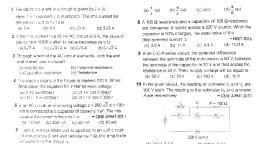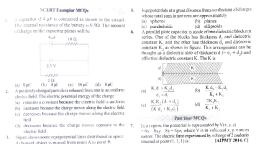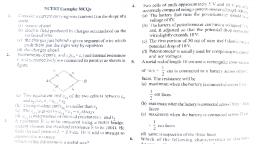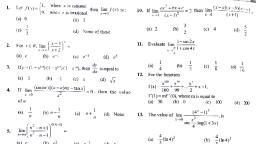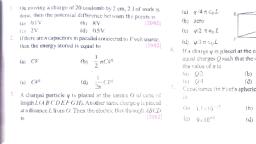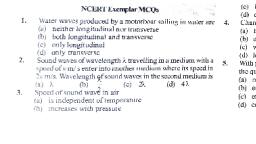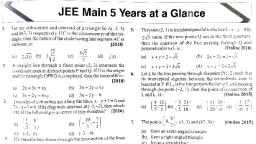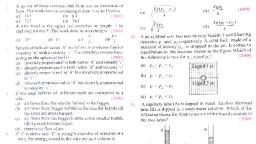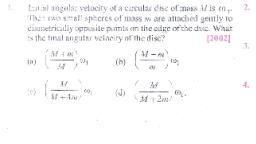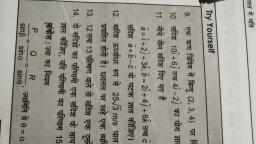Question 1 :
If $\overset{\rightarrow}{A}=\hat{i}-2\hat{j}-3\hat{k}\overset{\rightarrow}{B}=2\hat{i}+\hat{j}-\hat{k}$ and ${\vec C}=\hat{i}+3\hat{j}-2\hat{k}$, then the magnitude of $\overset{\rightarrow}{A}\times (\overset{\rightarrow}{B}\times \overset{\rightarrow}{C})$ is______
Question 2 :
The vector $\displaystyle \vec{c}$ is perpendicular to the vectors $\vec{a}=(2,-3,1),\vec{b} = (1,-2,3)$ and satisfies the condition $\vec{c}$.$(\hat{i}+2\hat{j}-7\hat{k}) =10$. Then the vector $\hat{c}$ =
Question 3 :
A man tries to remain in equilibrium by pushing with his hands and feet against two parallel walls. For equilibrium, <br><img style='object-fit:contain' src='https://storage.googleapis.com/teachmint/question_assets/JEE%20Advanced/5e8b1f2760d51c030bee41e4' height='104' width='67' ><br>
Question 4 :
A force of 98 newton is required to pull a body of mass $1 \times 10^2$ kg over the surface of the ice then find the coefficient of friction? (g $=$ 9.8 m s$^{-2}$)<br>
Question 5 :
A machine, in an amusement park, consists of a cage at the end of one arm, hinged at {tex}\mathrm O{/tex}. The cage revolves along a vertical circle of radius {tex} \mathrm r {/tex} {tex} \mathrm {(ABCOEFGH)}{/tex} about its hinge {tex} \mathrm { O } , {/tex} at constant linear speed {tex} \mathrm { v } = \sqrt { \mathrm { gr } } {/tex}.<br><img style='object-fit:contain' src="https://storage.googleapis.com/teachmint/question_assets/JEE%20Advanced/5f2bd6f123ac2366e3d3a507"><br>The cage is so attached that the man of weight '{tex} \mathrm {w}{/tex}' standing on a weighing machine, inside the cage, is always vertical. Then which of the following is correct?
Question 6 :
<p>It is more difficult to walk on ice than on a concrete road because<br/></p>
Question 7 :
A body of mass M is kept on a rough horizontal surface (friction coefficient =$\mu$ ). A person is trying to pull the body by applying a horizontal force but the body is not moving. The force by the surface on A is F where<br>
Question 8 :
Potential energy associated with a conservative force is given by <em>U</em> = <em>Ax</em><sup>2</sup> where <em>A</em> is a constant then
Question 9 :
You lift a suitcase from the floor and keep it on a table. The work done by you on the suitcase does not depend on.<br>
Question 10 :
When work is done on a body by an external force, its
Question 11 :
Figure shows a massless spring fixed at the bottom end of an inclined of inclination 37<sup>0</sup> (tan 37<sup>0</sup> = 3/4). A small block of mass 2 kg start slipping down the incline from a point 4.8 m away from free end of spring. The block compresses the spring by 20 cm, stops momentarity and then rebounds through a distance 1 m up the inclined, then (g = 10 m/s<sup>2</sup>) <br> <img style='object-fit:contain' style="max-width:240px;" src="https://storage.googleapis.com/teachmint/question_assets/JEE%20Advanced/5f16bfe8f1a5a149feab993b" />
Question 12 :
Two blocks, of masses {tex} \mathrm { M } {/tex} and {tex} 2 \mathrm { M } , {/tex} are connected to a light spring of spring constant {tex} \mathrm { K } {/tex} that one end fixed, as shown in figure. The horizontal surface and the pulley are frictionless. The blocks are released from rest when the spring is deformed. The string is light<br><img style='object-fit:contain' src="https://storage.googleapis.com/teachmint/question_assets/JEE%20Advanced/5f2bd7e323ac2366e3d3a532"><br>Which of the following are correct?
Question 13 :
A particle of mass {tex} m {/tex} is projected with a velocity {tex} v {/tex} making an angle of {tex} 45 ^ { \circ } {/tex} with the horizontal. The magnitude of the angular momentum of the projectile about the point of projection when the particle is at its maximum height {tex} h {/tex} is
Question 14 :
A bob of mass {tex} M {/tex} is suspended by a massless string of length {tex} L {/tex}. The horizontal velocity {tex} v {/tex} at position {tex} A {/tex} is just sufficient to make it reach the point {tex} B {/tex}. The angle {tex} \theta {/tex} at which the speed of the bob is half of that at {tex} A {/tex}, satisfies <br><img style='object-fit:contain' src="https://storage.googleapis.com/teachmint/question_assets/JEE%20Advanced/5f2d11cd6a4e10775e706fa2"><br>
Question 15 :
The figure shows a system consisting of (i) a ring of outer<br>radius {tex} 3 R {/tex} rolling clockwise without slipping on a horizontal surface with angular speed {tex} \omega {/tex} and (ii) an inner disc of radius {tex} 2 R {/tex} rotating anti-clockwise with angular speed {tex} \omega / 2 . {/tex} The ring and disc are separated by frictionless ball bearings. The point {tex} P {/tex} on the inner disc is at a distance {tex} R {/tex} from the origin, where {tex} O P {/tex} makes an angle of {tex} 30 ^ { \circ } {/tex} with the horizontal. Then with respect to the horizontal surface,<br><img style='object-fit:contain' src="5f229da41640f0732f84be49.jpg" /><br><img style='object-fit:contain' src="https://storage.googleapis.com/teachmint/question_assets/JEE%20Advanced/5f2d11d8398a24780aaf86f0">
Question 16 :
Two solid cylinders {tex} P {/tex} and {tex} Q {/tex} of same mass and same radius start rolling down a fixed inclined plane from the same height at the same time. Cylinder {tex} P {/tex} has most of its mass concentrated near its surface, while {tex} Q {/tex} has most of its mass concentrated near the axis. Which statement(s) is(are) correct?
Question 17 :
A solid cylinder rolls without slipping down the rough inclined surface, as shown. Choose the correct alternative (s). <br> <img style='object-fit:contain' style="max-width:240px;" src="https://storage.googleapis.com/teachmint/question_assets/JEE%20Advanced/5f16c3004bec8070e4e150fa" />
Question 18 :
A car acquires a velocity of $72\ kmph$ in $10 s$ starting from rest. Calculate its average velocity :
Question 19 :
A particle is moving in {tex} x y {/tex} -plane with {tex} y = x / 2 {/tex} and {tex} v _ { x } = 4 - 2 t . {/tex} Choose the correct options
Question 21 :
A train of length 50 m is moving with a constant speed of 10 m/s.Calculate the time taken by the train to cross an electric pole and a bridge of length 250 m.
Question 22 :
A mass m rotates in a vertical circle of radius R and has a circular speed $v_{c}$ at the top . If the radius of the circle is increased by a factor of 4, circular speed at the top will be

